I was looking at the periodic table of the elements the other day, as one does, when my eye fell upon the right-hand side of the chart. Right next to the noble gases at the extreme edge of the table is a column of elements with similar and interesting properties: the halogens. Almost all of these reactive elements are pretty familiar, especially chlorine, which most of us eat by the gram every day in the form of table salt. As the neighborhoods of the periodic table go, Group 17 is pretty familiar territory.
But for some reason, one member of this group caught my attention: iodine. I realized I had no idea where we get iodine, which led to the realization that apart from chlorine, I really didn’t know where any of the halogens came from. And as usual, that meant I needed to dig in and learn a little bit about the mining and refining of the halogens. At least most of them; as interesting as they may be, we’ll be skipping the naturally occurring but rare and highly radioactive halogen astatine, as well as the synthetic halogen tennessine, which lives just below it in the group.




















